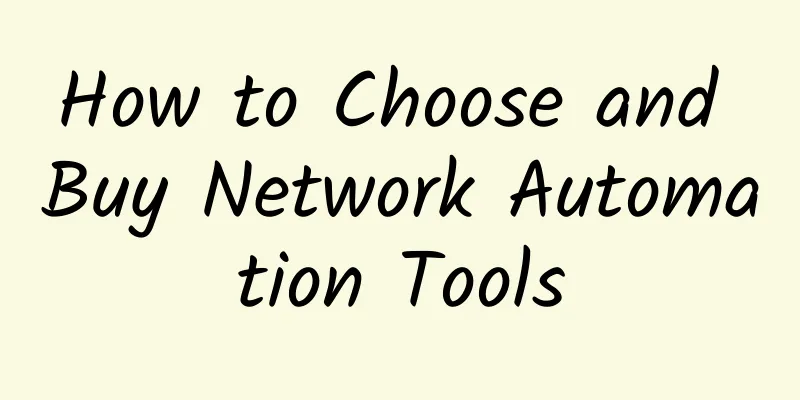How to Choose and Buy Network Automation Tools

|
The concept of network automation has been around for as long as networking has existed. Until now, it has been slow to gain traction for a number of reasons, including resistance from some network engineers. But a variety of factors are now converging to drive demand for network automation tools.
One factor is that more and more network teams are beginning to feel the pain of working in a fast-paced digital world, and the old ways simply don’t work. The manual method of configuring and updating routers and switches through the command line interface (CLI) is too slow and prone to errors. Additionally, the rise of software-defined networking (SDN), including software-defined WAN (SD-WAN), has enabled network automation tools to evolve from products focused on operations such as change management and configuration to policy and orchestration tools. Today, network automation tools are strategic, enable business alignment, and provide a roadmap to an ideal state of a fully intent-based system where the network can operate and protect itself. Here are seven key criteria that enterprises should consider when selecting the right network automation tools. 1. Single supplier or multiple suppliers? There are several third-party and vendor-specific network automation tools available today. Red Hat, NetBrain, and Forward Networks are three of the industry’s leading multi-vendor tools. And major network vendors including Cisco, Juniper, Arista, and Extreme all have their own automation platforms. Enterprises need to determine whether they want to work with one vendor or multiple vendors. This is a choice that enterprises need to make. If you choose a single vendor platform, you need to ensure that it works with the vendor's entire product line (not just a subset). If you choose a third-party tool, you need to choose one that supports current and future vendors whose equipment will be used in the enterprise's network. 2. Breadth of APIs It is important to understand that network automation tools must interface with other tools such as ServiceNow and Splunk. This means that each function is available as an API, but this is not always the case. Even if you are currently using only one tool, you may need to interface with another application in the near future to gain broader automation capabilities, so this should not be overlooked. 3. Orchestration When network devices change, oftentimes other elements of the infrastructure change as well. For example, adding a network device might require changes to firewall settings or connections to a load balancer. This drives the need for orchestration capabilities so that network automation tools can trigger other automation frameworks to change devices upstream or downstream of it. 4. Artificial Intelligence/Intent-Based Networking Capabilities The concept of an intent-based network is that it can operate, heal, and protect itself. This cannot be done through a series of rules because the environment changes too quickly. Instead, artificial intelligence capabilities should be included in the system to fully automate all operations so that the network itself can adapt to changes. ZK Research suggests the system has two modes of operation: one where engineers suggest changes to execute, and then one where the changes are fully executed without human intervention. This will allow customers to get comfortable with AI first. One question ZK Research has is, how do you know it’s truly AI-based? The answer is that the tool gets smarter over time. All changes should be fed back into the system as part of the learning data set and make the system smarter. 5. SaaS or On-Premise? Traditional network automation tools are only available as on-premises software or appliances. More and more enterprises are preferring to purchase tools in a software as a service (SaaS) model to ensure rapid deployment and continuous updates. Likewise, enterprises need to determine the option that best suits their operating model and compliance requirements. Note: ZK Research believes that all solutions will eventually be hybrid, where customers can keep data on-premises, but advanced AI capabilities and cross-company comparisons will be done in the cloud. On-premises solutions do not have the necessary functionality to provide real-time AI capabilities. 6. Compliance and Safety Reporting Industry-leading organizations are continuously pushing to bring IT and security operations together. This means that network automation tools need to provide information to demonstrate continuous adherence to security policies and meet compliance requirements. Reporting capabilities need to provide visibility into all stages of the network lifecycle, including planning, deployment, and optimization. 7. Ease of use This is an often overlooked component of a management platform. Feature-rich tools with a longer learning curve can take years for IT teams to realize their full value. Likewise, when a product is too technical, the company's business is at risk if the employees who understand it best leave. Network automation tools should be completely GUI-based, which means every function available through the command line interface (CLI) should also be accessible through the GUI. These tools should also be easy to use so that employees can use it. |
<<: Vinton Cerf, the 'Father of the Internet', Infected with Coronavirus
>>: Synopsys: Reducing 5G attack surface and making good use of technology "double-edged sword"
Recommend
The next technology that will change the world, 5G, is ready
Throughout history, every social transformation, ...
Where does the power of high-performance 5G core network come from?
The core network is the brain of the entire commu...
PIGYun: Los Angeles, USA/Korea VPS 60% off in July, monthly payment starts from 14.4 yuan
PIGYun is a Chinese merchant founded in 2019, pro...
Review of China Unicom in 2020: Being “down-to-earth” in the “hyper-realistic” development of 5G, and moving forward with firm “mixed reform”
As a technology that can rewrite the rules of the...
In the tug-of-war between NetOps and SecOps, what role does SD-WAN play?
Connectivity across campus, branch, cloud, and ed...
The UK finally stops using Huawei 5G equipment!
According to Reuters, British Secretary of State ...
What you need to know about Wi-Fi 7
As Wi-Fi 7 continues to make waves in the technol...
VULTR: KVM in 25 data centers around the world starting at $2.5 per month (supports hourly billing), $50 for new users
It has been more than 6 months since I last share...
Huawei Cloud Private Cloud Solution Reaches New Success at the End of the Year Sixteen Words Connect Enterprises Now and in the Future
[51CTO.com original article] Huawei is a company ...
After the fourth retail revolution, three experts from WOT tell you what real smart retail is!
[51CTO.com original article] On June 21, the WOT2...
Correctly understand the wrong ideas in RS-485 wiring process
[[185474]] RS485 bus is widely used in video surv...
Six advantages of single-pair Ethernet technology
As Single Pair Ethernet (SPE) gains more and more...
AI identification and root cause location of 5G wireless problems help improve network quality
Author: Zhang Zhe and Chen Juanjuan, unit: Hebei ...
People's Daily Overseas Edition: "China's Internet Speed" Empowers Thousands of Industries
[[386248]] As of the end of 2020, China has opene...
What will the future world look like under the 5G technology revolution?
Some time ago, Huawei's "Intelligent Wor...









